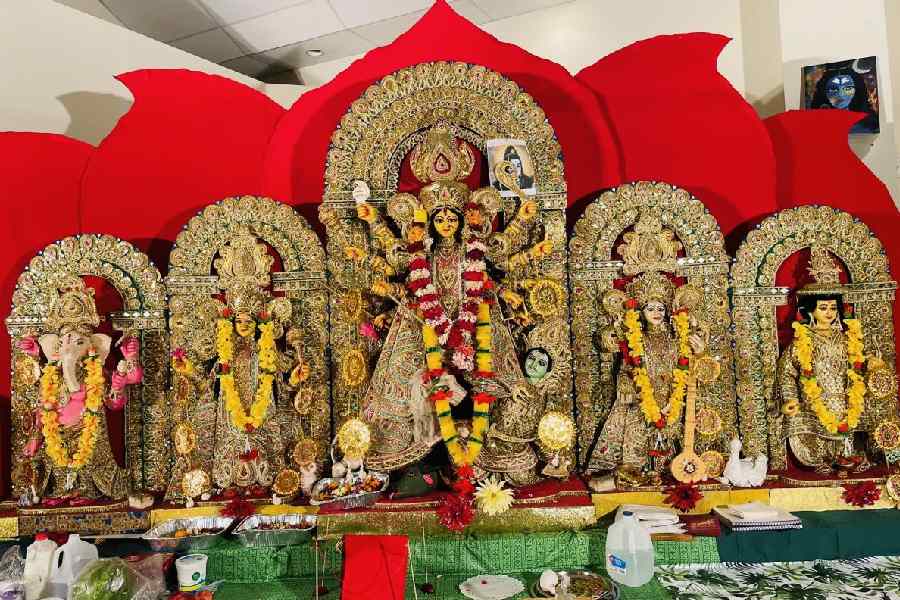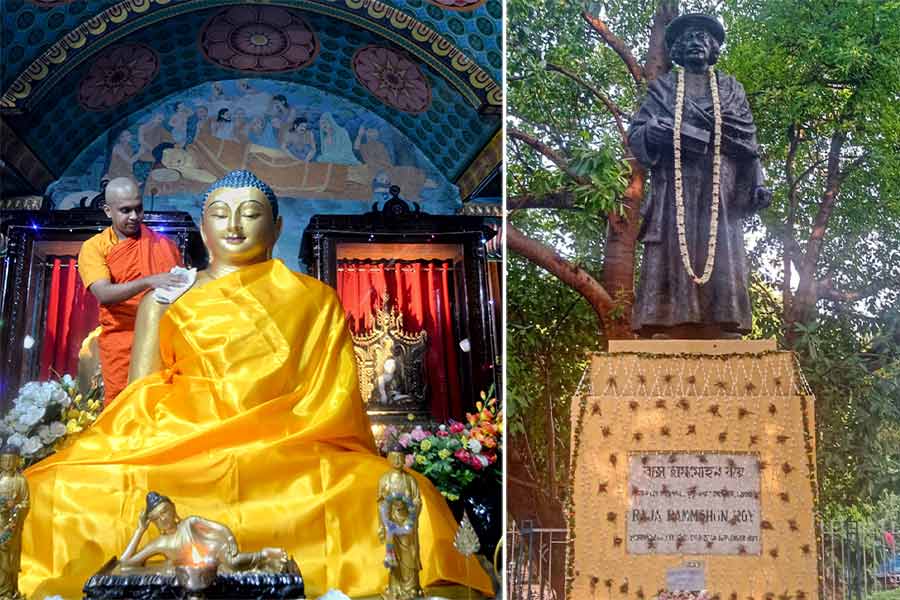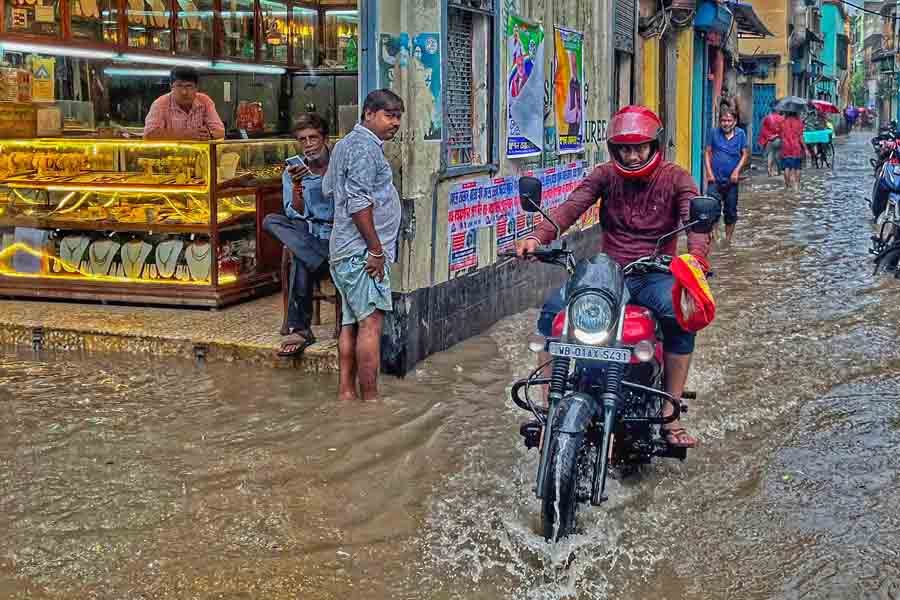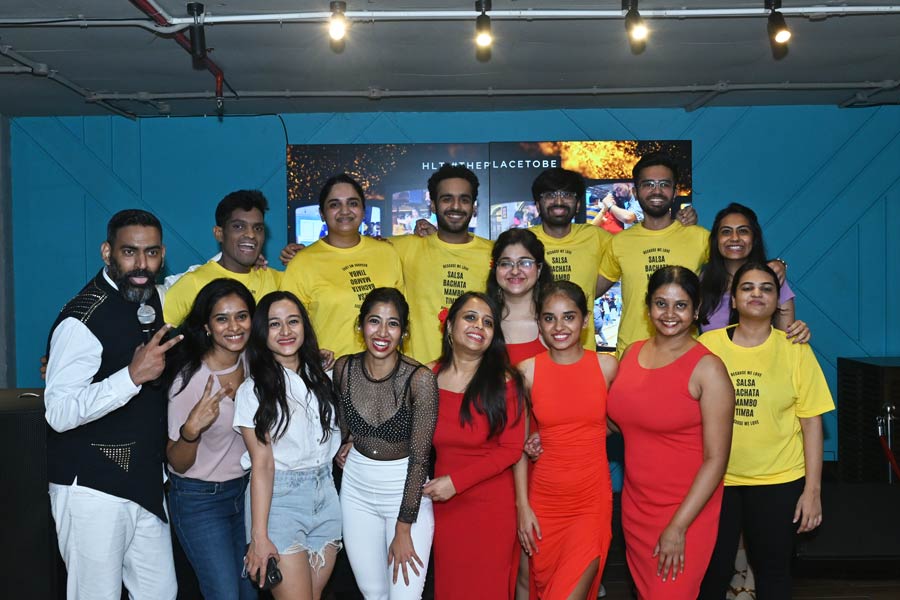West Hartford, Connecticut, US
It was 4am. My phone rang softly. I reached for it half-asleep, wondering who could it be so early in the morning. As I answered without noticing, a familiar voice greeted me “Bapi, Shubho Mahalaya”. It was my father who called from my hometown, Calcutta. I could feel the warmth and affection in his voice.
It has been over 10 years that I have been away from home in Connecticut, US. Being away from Calcutta during Durga puja, the most awaited celebration for a Bengali, is somewhat of a bittersweet experience.
Growing up in Salt Lake, as a child I remember the excitement that grips the city in the weeks leading up to Durga Puja. We lived in BH and BD blocks. All the streets and the pandals would light up for weeks to welcome Ma Durga. The streets would be abuzz with people of all ages visiting pandals, counting the number of idols, dancing to the beats of dhak and of course gorging on streetfood. I used to see the elders (parar kaku, jethu and dada) organising everything with ease. We used to have cultural programmes, sit-and-draw competition for the kids and delicious food for five days.

Ayon Sarkar at the Connecticut puja
Being in the US, so far away from home, has brought me close to local Bengali communities. All 50 states here have Bengali communities which organise Durga Puja. But it happens mostly on weekends, depending on the availability of the venue to do the Puja. In Connecticut, we enjoy Durga Puja not for five days but for two, during the weekend. I am lucky to be part of one such non-profit organisation, Hoichoi.
Hoichoi, as a group, always endeavours to connect people through various social events, cultural activities, musical gatherings, serving the community by organising food drives and celebrations like Durga puja, Diwali, Saraswati puja.
The planning for Durga puja here starts eight to 10 months in advance. It begins with looking for a place where we can host the puja. On finalising the venue, we plan for the events. We divide ourselves into multiple groups and look over different attributes, including food, logistics, cultural programmes and puja organisation. My passion for cooking has driven me to be a part of the food group where I immensely enjoy cooking with other members for all the people attending the Puja. All the effort, passion, and commitment poured into this undertaking by all the volunteers are nothing short of extraordinary. Being part of the puja committees gives me a sense of belonging, despite being away from home.
Generally, October is the month of leaf peepers in the eastern part of the US with the trees taking on different colours like red, orange and yellow. And Durga puja is just icing on the cake here. It’s time to unpack the kurtas, panjabis, saris and salwars from the suitcases. For the planning of the event, each committee comes up with its own plan of handling things and we spend days to come up with the sequence of events.
Our puja started at 9am on Saturday, October 21. This year, a church (the Westminster Presbyterian Church) in West Hartford became the sacred venue for our Durga Puja celebrations.
The idols were taken to the venue and decorated the previous day under the care of the puja committee. Since there is a dearth of priests everywhere, we have started grooming ourselves for the job. Following the sequence of Durga puja, Saturday morning and evening were dedicated to Sashthi and Saptami puja whereas Sunday morning started with Ashtami anjali, followed by Navami and ending with Dashami by the evening.
By 1pm, on both the days, we served lunch. When it comes to preparing for the grand feast, our journey transcends borders, our love for good food becoming a unifying force. We had headed to an Indian grocery store, a place that resonates with the flavours and aromas of our homeland. Here, we gathered the essential ingredients, spices, and herbs needed for bhog (offering) and traditional Bengali dishes. For Saptami, the day when Bengalis traditionally enjoy fish, we ventured into a Bangladeshi shop. And on Navami, the day we relish mutton dishes, we made our way to a Pakistani store. The owner, hailing from Pakistan, became our guide, offering insights into the art of selecting the finest cuts of meat.
There were cultural programmes organised on Saturday evening and Sunday afternoon. Hoichoi provides a platform for all to participate and perform. This gives the kids an opportunity to perform dance, sing songs and participate in plays, just as it used to be back home in our Salt Lake block.
There is a saying “You can take a Bengali out of Calcutta, but you cannot take Calcutta out of a Bengali.” Even though I miss Salt Lake during the Pujas, the support, camaraderie and shared celebrations of my community here have made the distance seem a little less daunting. They have shown me that home is not always a place; sometimes, it’s the people who make you feel like you belong, no matter where you are in the world.
The author, Ayon Sarkar, is a software professional who used to stay in BD Block and is currently settled in Connecticut, US
Jacksonville, Florida, US
The very mention of Durga puja conjures up memories of my parar puja at Nabadiganta Abasan Kalyan Samiti. I spent my growing up years at Kalindi on Chasipara Road and a large part of my waking hours were spent at the pandal there during the five-six days of the annual festivities.
Puja countdown started months ahead, with khnuti puja, right after Rathyatra. Elaborate plans for puja shopping and pandal-hopping were drawn up, along with well-considered decisions about what to wear on each day, where to go for lunch with friends and which dance moves to try at the bhashan procession to Babughat.
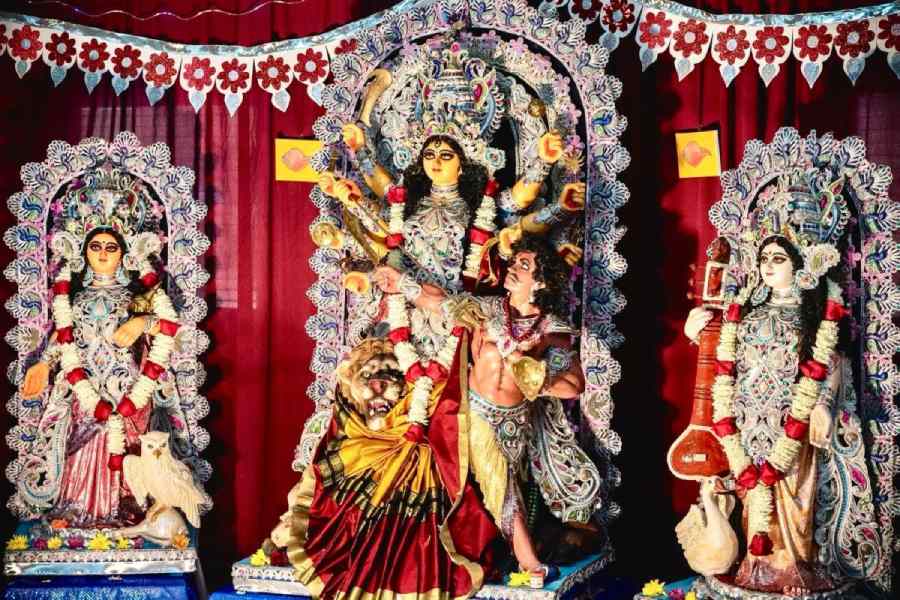
Durga puja at Jacksonville in Florida. This year the puja is next weekend
I remember rushing home from school so I could sit near the puja area, watching the colourful pandal being erected. How excited all of us, children of the housing complex, used to be the day our Mrinmoyee Ma arrived from Kumortuli before Mahalaya. Since our house was adjacent to the puja mandap, my mother used to welcome Durga Ma with the blowing of the conch shell. The collective excitement of the community’s children was so contagious that our parents would allow us to stay up way beyond midnight till after all the idols were housed safely in the mandap.
I spent many a happy hour decorating the pandal, drawing alpona on Chaturthi, and waiting with bated breath for thakurmoshai to remove the cover on Durga’s face, so we could finally see the goddess. Ma, along with kakimas and jethimas from the complex, would light earthen oil lamps to welcome Uma to her father’s home. My friends and I rehearsed for hours to perform a dance item as part of the cultural programme on Panchami. Pandal-hopping began in earnest from Sashthi. Sreebhumi, Lake Town Adhibashibrinda, Pragati Pally were some of the must-visit pujas nearby.
The other attraction was the mela at the Lake Town puja where we would be riding the Ferris wheel, taking part in carnival games, and gorging on streetfood. I had got separated from my father at the mela once as a child but was luckily found.
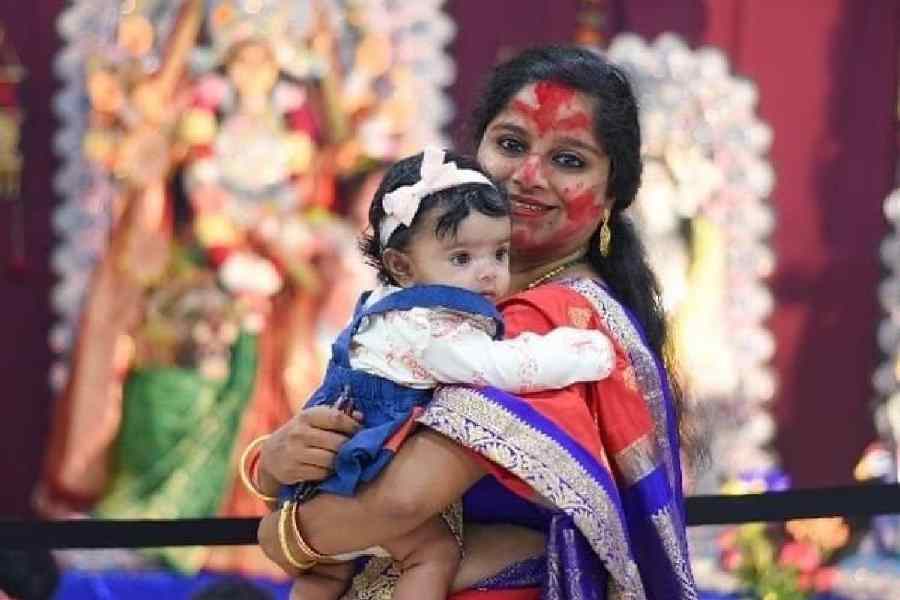
Roopkatha Ghosh
The good thing is that some things never change: Ashtamir anjali, Nabamir adda, decking up in Puja finery are what I relate with the spirit of Durga puja. And while the puja I now attend at the Bengali Association of North Florida-Jacksonville, St. Augustine (BANF) is located thousands of miles from home, it manages to evoke the essence of puja and recreate a feel of home in a land far, far away.
My husband, Dipra Ghosh, and I had moved to the Jacksonville-St-Augustine area in 2019. While I missed Puja at home, I was pleasantly surprised to see how warm and engaging the BANF puja was and how the organisation left no stone unturned to recreate the magic of Calcutta puja here.
The rituals are conducted over the weekend in the sprawling community hall within the Hindu Temple premises. Celebrations will kick off on Friday night with everyone chipping in to set up the pratima and aesthetically decorate the hall. The next two days will go by in a flurry of activity – helping with puja preparations, decking up in traditional finery, anjali, countless pictures with friends, khichuri-labra-begun bhaja-chutney-mishti lunch followed by some quality adda before reconvening for an entertaining cultural programme on Saturday evening where local talents will showcase their creativity. We will retire for the night after a delicious dinner to gather again on Sunday morning for the second day of Puja, replete with dhaker taley dhunuchi nach, sindur khela and exchanging Vijaya greetings with other Bengalis, many of whom have become close friends now.
My daughter, Riddhita or Nomi as she is lovingly called, was born in 2021 and attended the BANF Puja that year in my lap, when she was barely a few months old. I can never forget the loving welcome and pampering she received from all her didis, dadas, aunties and uncles!
Last year, she was excited to recite a few lines of her favourite poem at the BANF Mahalaya event, where she was indulged and applauded, much to her glee! These are the memories that make my Puja away from home special as well.
While my parar puja at Nabadiganta Abasan will always hold a very special place in my heart, the warmth and community feel of our BANF Puja make us feel at home away from home. I look forward to creating many more happy memories next weekend.
The author, Roopkatha Ghosh, is the mother of a two-year-old girl and stays in Jacksonville, Florida, US
Helsingborg, Sweden
Living in Kestopur two decades back meant crossing the canal during Durga puja and pandal-hopping in Salt Lake. There were no pujas of repute in the immediate neighbourhood. Our housing complex, Natural Green in Rabindrapally, was the first big one in Kestopur. We did hold a puja for the 300-odd families in 10 buildings but my role was mostly restricted to distributing and collecting flowers and bel leaves before and after pushpanjali. Other than this, there was also community lunch and dinner to be had together.
That left me ample time to chill in FD Park. Since I had passed out from Bidhannagar College, I had many friends in Salt Lake and some of them were volunteers at the FD Block puja. Our adda would be punctuated by gorging on phuchkas and munching on rolls on sale there. There was no crowd in those days and the ambience was relaxed. Dining at Salt Lake and Bypass restaurants was another fixture of the Puja nights.

The idol at the south Sweden puja
At the age of 42, I left Calcutta. On relocating to Helsingborg, Sweden, in 2014, I was hit by the absence of the vibrant and infectious festive spirit that informed Durga puja back home. In Sweden, with its cold climate, the month of October brought pitch-dark evenings, a stark contrast to the brilliantly illuminated streets of Calcutta adorned with colourful fairy lights.
During those initial years, we would often make the short trip to neighbouring Copenhagen city for a day, yearning to immerse ourselves in the festivities and offer my prayers to Ma Durga.
However, this brief excursion couldn’t fully satiate the longing that many Bengalis residing in Helsingborg shared for a grander and more extensive celebration, spanning multiple days.

Women priests perform Durga puja in Sweden
This marked the inception of the Bengali Cultural Society South Sweden (BCSofSS) in 2017, and we embarked on our journey by hosting our very first Durga puja that year. This celebration was made possible through the generous contributions of both Bengalis and non-Bengalis in our community.
Since that momentous beginning, as autumn descends and the air turns crisp, the Indian communities in Helsingborg are infected with Puja fever. Even during the challenging pandemic years, we remained steadfast in our commitment, conducting our puja with necessary restrictions and scaled-down grandeur to ensure the safety of all participants.
Our puja is held over three days. Last year, our priest’s father died some months before Puja, making him ineligible to perform the rituals. That left us in a soup. Finally it was decided that we would do the needful ourselves. We heard of Nandini Bhowmik performing puja at 66 Pally (in Kalighat). We got in touch with her and she gave us the confidence that gender and caste were no barriers to performing puja. Three women volunteered for the priest’s role, including my wife Mohua Deb. They were trained online in the meaning of the mantras as well as the use of the puja utensils by Bhowmik. Since then, we’ve proudly shattered the gender divide by having an all-women team of priests who conducted the puja this year as well.
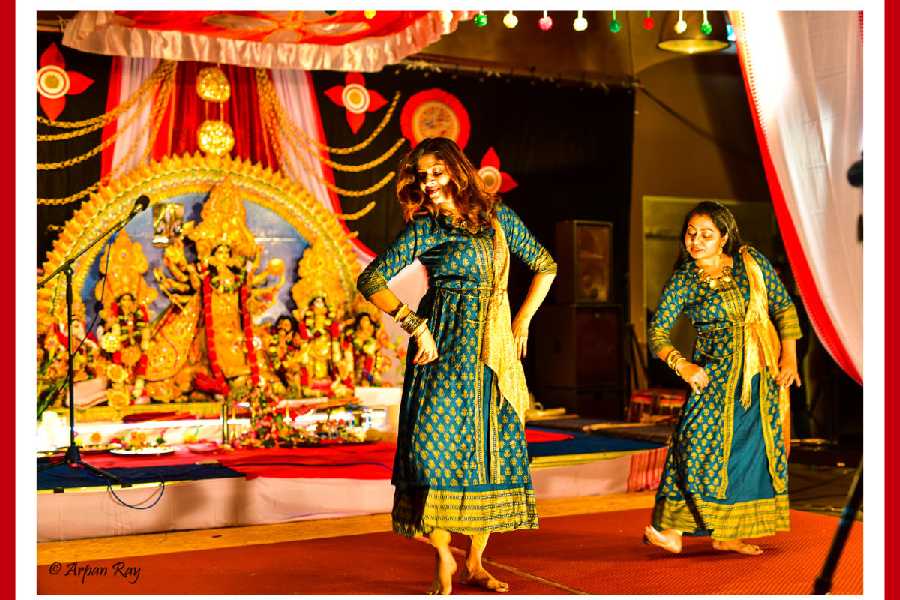
Cultural programme underway at the Helsingborg puja in Sweden
Last year, we also introduced theme-based Durga puja, a concept reminiscent of Calcutta’s celebrations. This year being our seventh, our theme ‘Saat Kahon’ honoured seven states of east and northeast India—Bengal, Bihar, Odisha, Assam, Manipur, Sikkim, and Nagaland, uniting them as a cherished tapestry in peepli and madhubani decoration that was done by our team over three months.
Visitors stepping into our pandal were greeted by a riot of colours and a rich confluence of elements, each representing the diversity of these seven states. Moreover, our cultural ensemble showcased these states through dance, song, and soul-stirring poetry. There were seven of the nine forms of the Mother Goddess, Navadurga, represented through pictures.
And what is a Bengali puja without a taste of home? For the three days of the Puja, we served Satey-patey, a seven-course traditional Bengali meal. There was an array of mouthwatering dishes, homemade Bengali sweets and a live luchi counter that transported visitors to the heart, or rather the stomach, of Bengal. There are many Bangladeshi families here which make wonderful chomchom and rasogolla. Some of our members make great narkoler barfi and goja. All of these were on offer during the Puja weekend.
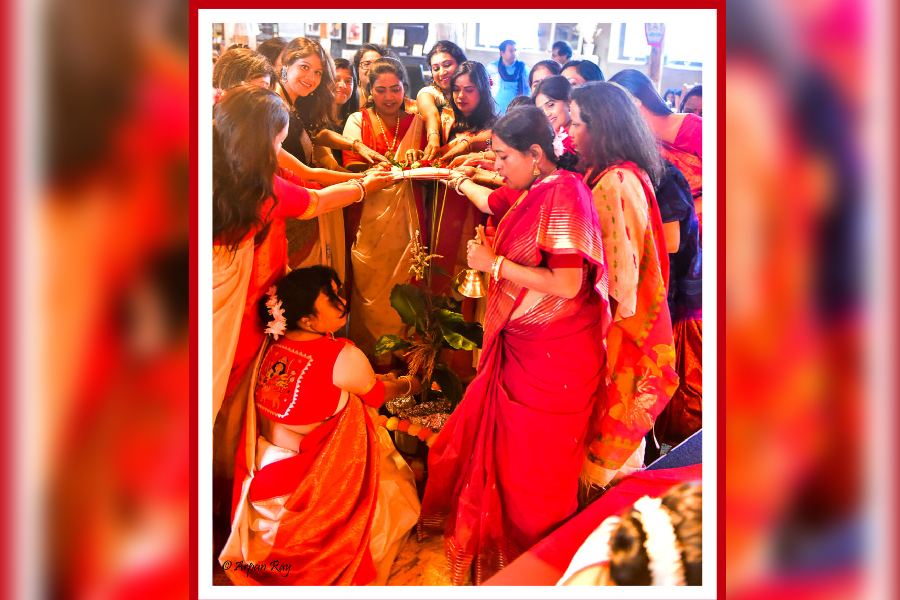
Kalabou snan being performed on Saptami in south Sweden
As in previous years, the interactive rituals of sindur khela, devibaran and visarjan dance united Indians of other communities from Sweden and neighbouring countries with us, Bengalis. Our puja attracts 20 per cent Swedish visitors. Thus in the presence of friends from around the world, the festival venue resonated with the profound emotions of a truly global celebration, where cultures and hearts converged.
The author, Dibyendu Das, is an IT professional living in Helsingborg, Sweden and a founding member of Bengali Cultural Society, South Sweden.


